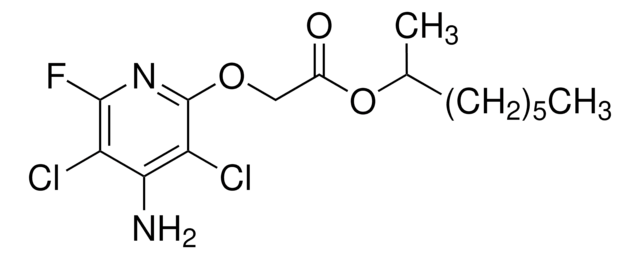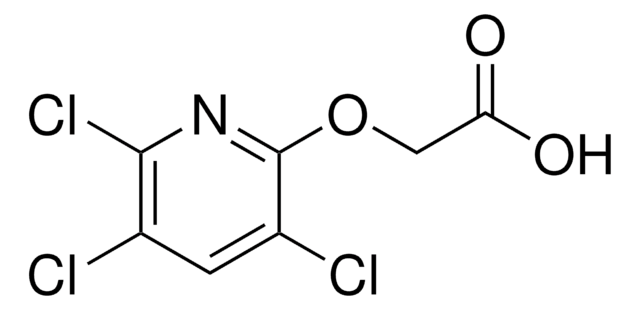36774
Picloram
PESTANAL®, analytical standard
Synonyme(s) :
Acide 4-Amino-3,5,6-trichloro-pyridine-2-carboxylique, Acide 4-amino-3,5,6-trichloropicolinique
About This Item
Produits recommandés
Qualité
analytical standard
Gamme de produits
PESTANAL®
Durée de conservation
limited shelf life, expiry date on the label
Pf
200 °C (dec.) (lit.)
Application(s)
agriculture
environmental
Format
neat
Chaîne SMILES
Nc1c(Cl)c(Cl)nc(C(O)=O)c1Cl
InChI
1S/C6H3Cl3N2O2/c7-1-3(10)2(8)5(9)11-4(1)6(12)13/h(H2,10,11)(H,12,13)
Clé InChI
NQQVFXUMIDALNH-UHFFFAOYSA-N
Vous recherchez des produits similaires ? Visite Guide de comparaison des produits
Application
- Herbicide Research: Picloram is explored for its synthesis, bioactivity, and mechanism of action as a herbicide in a novel compound class, showing its efficacy and potential applications in agriculture (Liu et al., 2024).
- Environmental Impact Studies: Research focuses on long-term conservation efforts using Picloram, demonstrating its effectiveness in ex situ plant conservation and understanding its broader environmental impacts (Kocot et al., 2024).
- Molecular Biology: Studies on the fluorescence sensor array for herbicides including Picloram highlight advancements in analytical chemistry, providing a robust method for qualitative and quantitative herbicide analysis (Zhang et al., 2024).
- Pharmacological Properties: The development and validation of methods for analyzing formulations containing Picloram showcase its stable nature and relevance in ensuring the safety and effectiveness of herbicidal products (Marczewska et al., 2024).
- Plant Growth Regulator Studies: Picloram′s role in the synthesis and herbicidal activity of novel compounds supports ongoing research into its use as a plant growth regulator, enhancing our understanding of its molecular effects on plant biology (Liu et al., 2024).
Informations légales
Mentions de danger
Conseils de prudence
Classification des risques
Aquatic Chronic 3
Code de la classe de stockage
11 - Combustible Solids
Classe de danger pour l'eau (WGK)
WGK 2
Point d'éclair (°F)
Not applicable
Point d'éclair (°C)
Not applicable
Équipement de protection individuelle
dust mask type N95 (US), Eyeshields, Gloves
Certificats d'analyse (COA)
Recherchez un Certificats d'analyse (COA) en saisissant le numéro de lot du produit. Les numéros de lot figurent sur l'étiquette du produit après les mots "Lot" ou "Batch".
Déjà en possession de ce produit ?
Retrouvez la documentation relative aux produits que vous avez récemment achetés dans la Bibliothèque de documents.
Les clients ont également consulté
Notre équipe de scientifiques dispose d'une expérience dans tous les secteurs de la recherche, notamment en sciences de la vie, science des matériaux, synthèse chimique, chromatographie, analyse et dans de nombreux autres domaines..
Contacter notre Service technique













